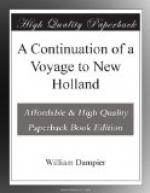New Britain.
The eastermost part of New Guinea lies 40 miles to the westward of this tract of land, and by hydrographers they are made joining together: but here I found an opening and passage between, with many islands; the largest of which lie on the north side of this passage or strait. The channel is very good, between the islands and the land to the eastward. The east part of New Guinea is high and mountainous, ending on the north-east with a large promontory, which I named King William’s Cape in honour of his present majesty. We saw some smokes on it; and, leaving it on our larboard side, steered away near the east land which ends with two remarkable capes or heads distant from each other about 6 or 7 leagues. Within each head were two very remarkable mountains, ascending very gradually from the seaside; which afforded a very pleasant and agreeable prospect. The mountains and lower land were pleasantly mixed with woodland and savannahs. The trees appeared very green and flourishing; and the savannahs seemed to be very smooth and even; no meadow in England appears more green in the spring than these. We saw smokes but did not strive to anchor here; but rather chose to get under one of the islands (where I thought I should find few or no inhabitants) that I might repair my pinnace, which was so crazy that I could not venture ashore anywhere with her. As we stood over to the islands we looked out very well to the north, but could see no land that way; by which I was well assured that we were got through, and that this east land does not join to New Guinea; therefore I named it New Britain. The north-west cape I called Cape Gloucester, and the south-west point Cape Anne; and the north-west mountain, which is very remarkable, I called Mount Gloucester.




